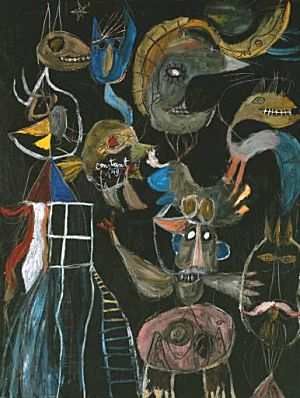Yesterday I got to go to the Tate Modern, which is always a treat. I suspect over the next few days I'll be posting about lots of different fascinating things that I found there, but I'll start with the one picture that grabbed me more than any other: Constant's After Us, Freedom (1949).
I love the painting for two reasons. Firstly because I have a thing about art that looks like it was made by a demented child, whether you call it primitivism, naive art or neo-expressionism, from Miró to Basquiat. While many people would write it off as just scribbles that take no talent, it speaks to me much more than any realist painting ever could. In a recent lesson, one of my teachers was sharing his 'the obviously fake reveals far more truth than the seemingly real ever could' philosophy, and I agree with him. I think paintings like this are a projection of the inner workings of the artists mind, something you as a viewer can relate to.
The second reason I was hooked by this painting, was the name. It had originally been called For Us, Freedom, but in a 1988 letter, Constant admitted that the freedom he hoped for still hadn't come, and so the painting's name was to be changed:
After the five years of the German Occupation, during which hardly any work of other painters was to be seen, the Rijksmuseum in Amsterdam organised a large show of contemporary Dutch art, entitled ‘Kunst in vryheid' (Art in freedom). This exhibition was a deception by the lack of any creative freedom - the worst kind of academicism. Shortly after (in 1946) I met Asger Jorn in Paris, who appeared to be a related mind. Our friendship would lead, 2 years later, to the foundation of CoBrA. The title of this painting was originally ‘A Nous la Liberté' opposing the false ‘freedom' of the above mentioned exhibition (and what followed after). A few years later, CoBrA had fallen apart and many of its former members were classified in museums as ‘experimentals', forming a new ‘style' contradictory to the real aims of the movement - My disappointment about this development led me to change the title to ‘Après Nous la Liberté'. I changed the title to express my doubts about the possibility of ‘free art' in an unfree society, and, at the same time, my hopes for the freedom all men are longing for.
I'm particularly interested by the idea that the artist has no control over their art, just like the author and their text, as Barthes argues in The Death of the Author. While this is sometimes celebrated, as the viewer/reader is in control and can make of the piece whatever they want, I find it sad that art that was created as a cry for freedom ended up drained of life and hope by the art establishment.


No comments:
Post a Comment